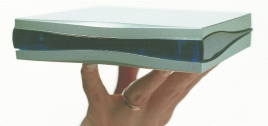New Linux-powered devices harness XoIP convergence
Mar 12, 2003 — by LinuxDevices Staff — from the LinuxDevices Archive — views [Updated Mar. 13, 2003] — Swedish datacom company i3 Micro Technology announced a family of three Linux-powered devices and associated services that are meant to capitalize on the emerging convergence of the Internet, telephony, and TV over IP-based broadband networks.
[Updated Mar. 13, 2003] — Swedish datacom company i3 Micro Technology announced a family of three Linux-powered devices and associated services that are meant to capitalize on the emerging convergence of the Internet, telephony, and TV over IP-based broadband networks.
The three devices, which i3 refers to as a “triple play” combination, are the Mood Box, the Vood Residential Gateway (“Vood” stands for “voice options on demand”), and the i3 Centre management server.
Additionally, i3 offers the Mood Movie server, for VoD (video on demand) content, and the Mood Live server, for live TV. The Mood Box, a cost-effective, attractive consumer set-top box, was previewed last summer at LinuxWorld in San Francisco.

The Model 111 Vood Terminal Adapter
i3 says its VoIP products are interoperable with standards-based third-party gatekeepers, proxies, soft switches, and PSTN gateways using H.323, SIP, and MGCP. Typical capabilities offered are said to include . . .
- VoIP calls to another VoIP-user or to the PSTN, using your existing analog phone.
- Dialing a number using the analog phone key pad or click-to-dial from your PC or TV.
- Accessing the Internet from your PC or TV.
- Reading your emails from your PC or TV.
- Listening to voice mails from any Internet connected PC or a TV
- Receiving Caller ID on an analog phone/Caller ID device or as a pop-up on the TV.
- Managing the supplementary services from your PC or TV using a web interface to the VRG.
- Real-time communication, like instant messaging/chat, video calls and on-line gaming on the TV or PC.
Hans Holmberg, president of i3, said i3 is currently in discussions to launch these type of services in Europe, North America and Asia.
Linux inside
“We use Linux and embedded Linux in all our products,” said Mats Hovmöller, i3 business development manager.
Qt/Embedded is used as i3's embedded GUI platform. For web access, i3 uses the Opera embedded browser — although some middleware on the Mood box has been specifically ported to Mozilla, Hovmöller added.
Additionally, third-party integration of open web services is facilitated by interfaces that are primarily implemented in Java.
Why Linux?
“The main reason for choosing Linux was to control our own destiny, and to be in control of the source,” said Chris Chalkitis, i3 general manager for streaming products. “The vast amount of tool-sets available has shortened the development cycle. Also, i3 will share some code with the community as we feel giving something back is very important.”
“We see Linux as a winner in the embedded market, and predict that other commercial operating system vendors will struggle and only be successful in niche markets,” predicted Hovmöller. “We have seen some Windows CE initiatives, but we believe Linux will dominate.”
This article was originally published on LinuxDevices.com and has been donated to the open source community by QuinStreet Inc. Please visit LinuxToday.com for up-to-date news and articles about Linux and open source.